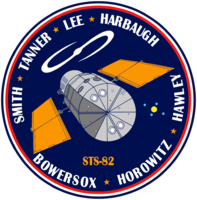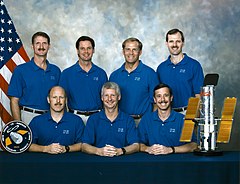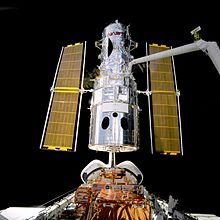STS-82
 | |
| Dane misji | |
| Indeks COSPAR | 1997-004A |
|---|---|
| Zaangażowani | |
| Oznaczenie kodowe | STS-82 |
| Pojazd | |
| Wahadłowiec | |
| Załoga | |
 Siedzą od lewej: Kenneth Bowersox, Steven Hawley, Scott Horowitz. Stoją od lewej: Joseph Tanner, Gregory Harbaugh, Mark C. Lee, Steven Smith | |
| Dowódca | |
| Start | |
| Miejsce startu | |
| Początek misji | |
| Orbita okołoziemska | |
| Apogeum | 574 km |
| Perygeum | 475 km |
| Okres orbitalny | 95,2 min |
| Inklinacja orbity | 28,47° |
| Lądowanie | |
| Miejsce lądowania | KSC, Pas startowy 15[1] |
| Lądowanie | 21 lutego 1997 08:32:26 UTC[1] |
| Czas trwania misji | 9 dni, 23 godz., 37 min, 9 sek[1] |
| Przebyta odległość | 10,5 mln km |
| Liczba okrążeń Ziemi | 149 |
| Program lotów wahadłowców | |
STS-82 – druga (SM2) misja serwisowa promu Discovery do Kosmicznego Teleskopu Hubble’a, która trwała 9 dni i 23 godziny. Start odbył się z przylądka Canaveral 11 lutego 1997 roku. Była to dwudziesta druga misja wahadłowca Discovery i osiemdziesiąta druga programu lotów wahadłowców[2].
Załoga
- źródło[2]
- Kenneth Bowersox (4)*, dowódca
- Scott Horowitz (2), pilot
- Mark C. Lee (4), specjalista misji
- Steven Hawley (4), specjalista misji
- Gregory Harbaugh (4), specjalista misji
- Steven Smith (2), specjalista misji
- Joseph Tanner (2), specjalista misji
- *(liczba w nawiasie oznacza liczbę lotów odbytych przez każdego z astronautów)
Parametry misji
- Masa:
- startowa orbitera: - kg
- lądującego orbitera: 96 762 kg[1]
- Perygeum: 475 km
- Apogeum: 574 km
- Inklinacja: 28,47°
- Okres orbitalny: 95,2 min
Cel misji
Drugi lot serwisowy do Kosmicznego Teleskopu Hubble’a, umieszczonego na orbicie w kwietniu 1990 roku (Discovery STS-31)[2]. Zadaniem misji SM2 (Servicing Mission 2) była instalacja dwóch nowych instrumentów, które rozszerzyły zakres długości fal rejestrowany przez teleskop o bliską podczerwień, zarówno w obrazowaniu, jak i spektroskopii. Astronauci dokonali również niezbędnych napraw, głównie systemów teleskopu. Nowymi instrumentami zainstalowanymi były: Spektrometr Obrazujący Teleskopu Kosmicznego (STIS), który zastąpił Spektrograf Wysokich Rozdzielczości Goddarda (GHRS), oraz Kamera Bliskiej Podczerwieni i Spektrometr Multiobiektowy (NICMOS) zainstalowany w miejsce Spektrografu Obiektów Słabych (FOS)[3].
Spacery kosmiczne
- źródło[2]
- M. Lee i S. Smith – EVA 1
- Start EVA 1: 14 lutego 1997 - 04:34 UTC
- Koniec EVA 1: 14 lutego - 11:16 UTC
- Łączny czas trwania: 6 godz, 42 min
- G. Harbaugh i J. Tanner – EVA 2
- Start EVA 2: 15 lutego 1997 - 03:25 UTC
- Koniec EVA 2: 15 lutego - 10:52 UTC
- Łączny czas trwania: 7 godz, 28 min
- M. Lee i S. Smith – EVA 3
- Start EVA 3: 16 lutego 1997 - 02:53 UTC
- Koniec EVA 3: 16 lutego - 10:04 UTC
- Łączny czas trwania: 7 godz, 11 min
- G. Harbaugh i J. Tanner – EVA 4
- Start EVA 4: 17 lutego 1997 - 03:45 UTC
- Koniec EVA 4: 17 lutego - 10:19 UTC
- Łączny czas trwania: 6 godz, 34 min
- M. Lee i S. Smith – EVA 5
- Start EVA 5: 18 lutego 1997 - 03:15 UTC
- Koniec EVA 5: 18 lutego - 18:32 UTC
- Łączny czas trwania: 5 godz, 17 min
Zobacz też
Przypisy
- ↑ a b c d e Mark Wade: STS-82 (ang.). W: Encyclopedia Astronautica [on-line]. [dostęp 2017-07-25].
- ↑ a b c d Tomáš Přibyl: Dzień, w którym nie wróciła COLUMBIA. Bielsko-Biała: Wydawnictwo >DEBIT<, s. 172. ISBN 83-7167-224-1.
- ↑ Steve Whitfield: Hubble. Kosmiczny teleskop. Warszawa: Prószyński Media Sp. z o.o., s. 18-19, seria: Historia podboju Kosmosu. ISBN 978-83-7648-999-5.
Linki zewnętrzne
- podsumowanie misji STS-82 na stronie KSC (ang.)
- Mark Wade: STS-82 (ang.). W: Encyclopedia Astronautica [on-line]. [dostęp 2017-07-25].
- Spaceflight mission report: STS-82 (ang.). Spacefacts. [dostęp 2017-07-25].
Media użyte na tej stronie
The flag of Navassa Island is simply the United States flag. It does not have a "local" flag or "unofficial" flag; it is an uninhabited island. The version with a profile view was based on Flags of the World and as a fictional design has no status warranting a place on any Wiki. It was made up by a random person with no connection to the island, it has never flown on the island, and it has never received any sort of recognition or validation by any authority. The person quoted on that page has no authority to bestow a flag, "unofficial" or otherwise, on the island.
Autor: NASA on The Commons, Licencja: No restrictions
Attached to the "robot arm" the Hubble Space Telescope is unberthed and lifted up into the sunlight during this the second servicing mission designated HST SM-02.
Image # : STS082-709-097The crew assigned to the STS-82 mission included (seated front left to right) Kenneth D. Bowersox, commander; Steven A. Hawley, mission specialist; and Scott J. Horowitz, pilot. On the back row (left to right) are Joseph R. Tanner, mission specialist; Gregory J. Harbaugh, mission specialist; Mark C. Lee, payload commander; and Steven L. Smith, mission specialist. Launched aboard the Space Shuttle Discovery on February 11, 1997 at 3:55:17 am (EST), the STS-82 mission served as the second Hubble Space telescope servicing mission.
STS-82 Mission Insignia
- STS-82 is the second mission to service the Hubble Space Telescope (HST). The central feature of the patch is HST as the crew members will see it through Discovery's overhead windows when the orbiter approaches for rendezvous, retrieval and a subsequent series of spacewalks to perform servicing tasks. The telescope is pointing toward deep space, observing the cosmos. The spiral galaxy symbolizes one of HST's important scientific missions, to accurately determine the cosmic distance scale. To the right of the telescope is a cross-like structure known as a gravitational lens, one of the numerous fundamental discoveries made using HST Imagery. The names of the STS-82 crew members are arranged around the perimeter of the patch with the extravehicular activity's (EVA) participating crew members placed in the upper semicircle and the orbiter crew in the lower one.




